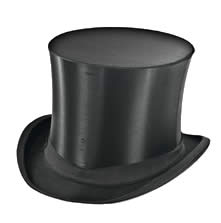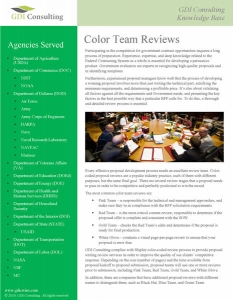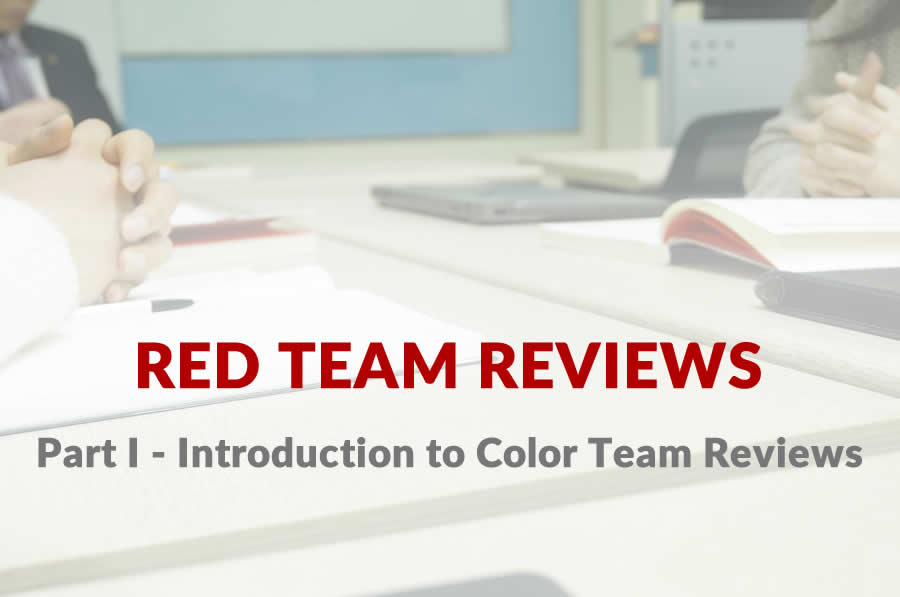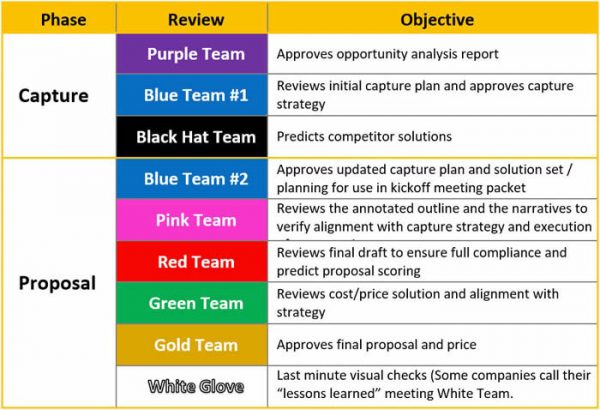Note: This is the first part of a four-part series on Red Team Reviews as conducted in federal opportunity proposal writing space (although it can also be used in other situations like state or major commercial endeavors).
Part I is a short introduction to color team (gate) reviews and their necessity. Part II will cover the goals and expectations of a properly conducted Red Team exercise. Part III will delve into how to prepare for it to make sure it is done correctly (remember Lincoln’s saying that “give me six hours to chop down a tree and I will spend the first four sharpening the ax,” and finally Part IV will cover the different aspects of conducting an effective and successful Red Team Review exercise.
Part I – Introduction to Color Team Reviews
1. What do we mean by Color Team (Gate) Reviews?
Although this might seem a trivial question to many, it is indeed an item of controversy as to what a color gate review should cover and what should be its goals. In the most general terms, color gate reviews are gate reviews conducted to enhance the quality of the proposal and align it to the requirements of the RFP. Each “color” depicts a specific stage of the review and enhancement process and also provides a time constraint on the effort to ensure that the proposal is prepared on time, with quality.
2. What is the Need for Color Gate Reviews?
To understand the logic and necessity of color gate reviews, we must first touch on the proposal writing methodologies themselves. There are mainly 2 different ways of writing a proposal which I have labeled as:
- One-Shot – Kill All – Create the structure and then start writing the best narrative you can for each section and don’t stop until you have given it your best (you and your team), then move to the next section. So, by the time the team finishes all the sections, you have a proposal that is good to go. You have been focused and have fully devoted yourself and your team’s resources to each section, have discussed every word and sentence within the team and have finalized a winning proposal. Quick and Easy.Unfortunately, this is the methodology used by most technical people, scientists, and people who have not worked with the Government before. And that is why they continue to lose excellent opportunities even though their solutions are truly innovative and to the point. Don’t think you don’t have this problem at your company. Most technical oriented people are prone to some percentage of this mindset; just write the proposal in one shot and get it done with. You, as the proposal manager/director/owner, should always be aware of this threat in your environment.
- Progressive Escalation of Quality (PEQ) – The pragmatic team knows that it won’t have all the information at hand to start writing and finishing each section in one go. It knows that human beings are prone to mistakes which can be rectified by repeat and multiple iterations of work. The team knows that a PEQ methodology, although more time consuming, can provide a higher quality product at the end. And, if you want to use the latest group work theories, this way of proposal writing offers more opportunities for teamwork, and although managing it is more time consuming, it produces a higher ROI from the personnel you expend in this effort. It is not maxed by your Guru’s capabilities; it is based on the cumulative capabilities of the entire team.
So when you are going by the PEQ methodology, you need Key Performance Indicators (KPIs) to gauge your progress (quality-wise), and that is where color gate reviews come in, to keep you in the right direction. The color gate reviews essentially provide you the means to gauge how well you have progressed. To speak in federal proposal terms, they facilitate evaluating the presence or absence of win themes and discriminators, compliance with the RFP requirements, and responsiveness to the customer’s needs that produced the RFP in the first place.
3. Types of Color Gate Reviews and “Color” Designation:
Here is a table that lists the most common color gate reviews:
We will provide detail description of each in different articles. Below is a snippet of each of the color gate reviews during the Proposal process:

Blue Team Review:
A Blue Team review is conducted to ensure that the essential planning for the proposal is done, the compliance matrix and annotated outline of the proposal are prepared and are complete and that all writing tasks are assigned and timetables for each task and future reviews are established. Discriminators and win themes should also be set and/or gaps identified (if not done before).

Pink Team Review:
The Pink draft should have content under each and every section of the prepared Annotated Outline of the proposal, with emphasis on having the correct content but no correct format, style, or grammatical perfection. Some companies go by percentage complete which is labeled anywhere from 40-50% to 65-70% per their internal systems. But the main goal is basically to have the content and details planned for in the annotated outline and identify the missing parts at the same time.

Red Team Review:
Whether Pink Team Review or Red Team Review is the most important and crucial review has always been the subject of debates, but Red draft of the proposal is indeed a significant milestone in the preparation of the proposal. It is sometimes considered 85-90% complete but essentially should be a narrative near-final in data, tables, graphics, resumes, and, most importantly, finalized narratives. It should be fully compliant and reflect the perspective of the customer’s evaluation requirements. An independent reviewer should be able to tell you if this is a winning proposal or not, as is.

Gold Team Review:
No human or human team is perfect. Even though the goal of the Red draft is to provide a final product, it is understood that it still needs enhancements. So, once the Red Team Review is done and enhancements worked in, you still need to do another review, which many consider the 99% complete point. This is the review done to ensure that the proposal is ready to submit. The focus here is on high-level win themes and discriminators, and any last-minute nuances.

Green Team Review:
As the Price Volume is usually completely different from the technical volume with different teams working on it, it has its own review process. The Green Team review is the review of the price volume, usually done concurrent with or after the Red Team review and generally before the Gold Team review. In addition to compliance, one of the most critical items that must be checked is to ensure that the Price Volume reflects what is presented in the Technical Volume.

White Team (Glove) Review:
White Glove reviews are a remnant of old ages when you had to print the proposal. And, yes, you still have to do that for many agencies. It is a page by page review of the proposal to catch any last-minute glitches in printing or in formatting (for online submissions), with a focus on compliance.

Black Hat Review:
Black hat reviews are performed in the capture phase and not in the proposal development phase. But since they are sometimes mentioned in color gate reviews, it should be mentioned that they are an exercise to gauge the capabilities and advantages/disadvantages of the competitors towards a go/no-go decision. Some companies perform Black Hat exercises in the proposal stage, as well, to shape their own proposals accordingly.
In Summary:
As can be seen, to arrive at a quality product (proposal) that has a high win probability, you need to bring in the “power of the masses.” You must prepare the proposal so that its quality improves through the bid period lifecycle, through the contribution of multiple people. That is why reviews at specific and critical stages of the work are crucial.
All of the mentioned review gates are important and help in the overall quality improvement of the proposal. Of them, all, perhaps the most talked-about are Red and Gold Team reviews and most underestimated are Pink and Blue. Notwithstanding which color gate you are going after, there are always 3 aspects that you should be clear about 1) What do you expect out of that gate review 2) What preparations do you need to take into account, and 3) How are you going to conduct it. If you have a clear picture of these 3 aspects and a proper course of action for each, you will undoubtedly have a successful gate review, which will enhance the quality of your proposal.
We will cover each of these aspects in our future articles.
For more information on GDI Consulting’s Color Team Review process and how this process can help you position your proposal to win, download GDIC Color Team Review Guide.






